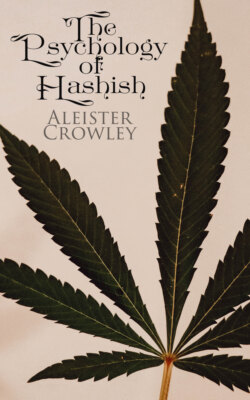Читать книгу The Psychology of Hashish - Aleister Crowley - Страница 7
Chapter V
Оглавление“For this Paternal Intellect, which comprehendeth the Intelligibles and adorneth things ineffable, hath sowed symbols through the World... Comprehending that Intelligible with extended Mind; for the Intelligible is the flower of Mind... A similar fire flashingly extending through the rushings of air, or a Fire formless whence cometh the Image of a Voice, or even a flashing Light abounding, revolving, whirling forth, crying aloud. Also there is the vision of the fire-flashing Courser of Light, or also a Child, borne aloft on the shoulders of the Celestial Steed, fiery, or clothed with gold, or naked, or shooting with the bow shafts of Light and standing on the shoulders of the horse; then if thy meditation prolongeth itself, thou shalt unite all these symbols into the Form of a Lion.”
— ZOROASTER.
The most important of the psychological results of my experiments seem to me to lie in (A). I devoted much pains to obtaining this effect alone by taking only the minutest doses, by preparing myself physically and mentally for the experiment, and by seeking in every possible way to intensify and prolong the effect.
Simple impressions in normal consciousness are resolved by hashish into a concatenation of hieroglyphs of a purely symbolic type.
Just as we represent a horse by the five letters h-o-r-s-e, none of which has in itself the smallest relation to a horse, so an even simpler concept such as the letter A seems resolved into a set of pictures, a fairly large number, possibly a constant number, of them. These glyphs are perceived together, just as the skilled reader reads h-o-r-s-e as a single word, not letter by letter. These pictorial glyphs, letters as it were of the word which we call a thought, seem to stand at a definite distance in space behind the thought, the thought being farther from the perceiving soul. Looking at each glyph, one perceives, too, that itself is made up of other glyphs yet nearer to the Self, these glyphs, however, being formless and nameless; they are not truly perceived, but one is somehow aware of them.
Unfortunately, the tendency to fall into effect (B) makes it very difficult to concentrate on the analysis of these ideas, so that one is hurried on to a similar examination of the next thought. It is curious, though, to notice how this analysis corresponds to the worlds of the Qabalah, the single “pure soul” at the back of all, the shadowy “creative” world, the varied “formative world,” and the single though concrete “material” world.
It puzzles one, too (at the time, in the very course of the analysis), to ask: If the external simple impression be made up of so many glyphs, and each of these again of many more, how can one ever return to the “pure soul”? For all the while one is clearly conscious of a simple Ego or “pure soul” which perceives all this.
The only solution appears to lie in a metaphysical identification of Monotheism and Pantheism.
Again, one is conscious of a double direction in the phenomena. Not only is it true to say that the thoughts are analysed into glyphs and so on, back to the pure soul; but also that the pure soul sends forth the glyphs, which formulate the thought. Here again we must identify the Atman system of Hinduism centered in Ego with the Anatta system of Buddhism, in which the impressions are all.
Further, there arises an exceedingly remarkable state of mind, described in the Bhagavad-Gita (I quote Arnold):
“I, who am all, and made it all, abide its separate Lord.”
The experience could not be better phrased. Zoroaster, too:
“Who first sprang from Mind, clothing the one Fire with the other Fire, binding them together, that he might mingle the fountainous craters, while preserving unsullied the brilliance of His own Fire.”
“Containing all things in the one summit of his Hyparxis, He Himself subsists wholly beyond.”
It is almost impossible to describe so purely metaphysical a state, which involves clearly enough a contradiction in terms. Yet the consciousness is so vivid, so intense, so certain, that logic is condemned unflinchingly as puerile. The best escape for the logician is to argue that the three assertions are closely consecutive, so closely that mind thinks them one; just as the two points of a pair of compasses pressed upon certain parts of the body are felt as one point only. While the mystic will mutter some esoteric darkness about the true interpretation of the doctrine of the Trinity.
I think one should add that these results of my introspection are almost certainly due to my own training in philosophy and magic, and that nothing but the intensification of the introspective faculty is due to the hashish. Probably, too, this effect (A) would be suppressed or unnoticed in a subject who had never developed his introspection at all.
Yet I am inclined to believe that this effect (A) is the true effect; and that Ludlow’s “access of self-consciousness” is but the same operating on the organization of a man evidently nervous and timid.
